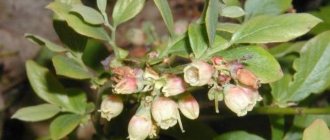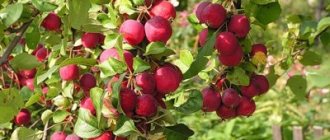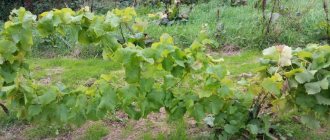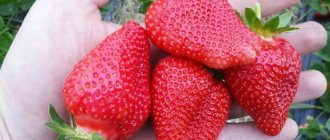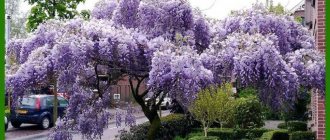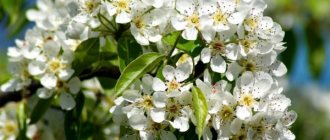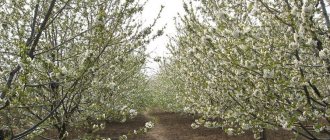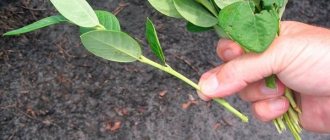Clematis Kaiser, which came to Eastern Europe relatively recently, quickly attracted the attention of flower lovers. They began to decorate gazebos, dachas, fences with fragrant vines, and began to use clematis for vertical gardening of country houses. The mid-early hybrid Kaiser, bred in Japan in the nineties, grows not only in the south, but also takes root in mid-latitudes. Clematis surprises with its large and variegated inflorescences, in which different shades intertwine. In spring and summer the pink color predominates; by autumn the petals become dark purple.
Description of the variety
Clematis variety Kaiser is a striking, profusely flowering plant with large double flowers. The bush grows quickly, actively forming side shoots. They are densely covered with large elliptical leaves with jagged edges of a rich green color. During the season, the vine grows up to one and a half meters and produces from six to ten new stems.
Despite the fact that clematis Kaiser is a hybrid variety, it requires careful attention and fairly careful care. Most likely, this is due to the fact that the variety was not originally intended for cultivation in the middle zone. In the Southern regions, where the weather is more stable and the soil is fertile, its cultivation requires much less labor and time.
In principle, clematis Kaiser also feels good in the Central zone if the wintering of the plants is well organized. But to achieve sustainable, abundant flowering, you will have to make an effort. And in this case, it is better to have experience in growing less capricious varieties of clematis.
A distinctive feature of the clematis variety Kaiser is its double flowers, which, under favorable conditions, cover the plant like a carpet throughout the summer season.
Features of flowering
Not a single photo, even a professional one, can convey the beauty of clematis Kaiser during the period of prolonged flowering. Depending on weather conditions, last year's shoots of Kaiser clematis begin flowering in May-June. These flowers are the largest, reaching 14-16 cm in diameter.
At the end of June or beginning of July, the second wave of flowering begins. The buds set on new shoots. And although the flowers are a little smaller during this period, their abundance makes the plants look like a cascading waterfall of purple hues. The second stage continues until September.
The flowers of clematis variety Kaiser are large and double, consisting of many layers of petals. The lower tiers are made of wider oval petals with a sharp edge. The upper petals are needle-shaped.
The play of colors in the bud is amazing. All shades of pink, purple, lilac and purple flowers can be combined in one bud. Small inclusions of light shades make the flower very delicate, especially in combination with a light yellow or cream center.
Interesting fact!
The color of the buds of Clematis variety Kaiser largely depends on weather conditions and time of year. By the end of the growing season, the flower petals acquire a rich purple color with light shades of autumn purple. During a long cold spell, the middle acquires a greenish tint. Therefore, very often the same clematis is mistaken for two different varieties.
According to experienced gardeners, achieving abundant flowering of Kaiser clematis under conditions of sudden changes in temperature, and especially humidity, is a difficult but completely doable task. This requires some knowledge and experience.
- Clematis variety Kaiser likes to grow in sunny places and does not like heat. Therefore, you should not use it to decorate arches or steles. He will prefer to grow near the western or eastern walls of the house, terrace or gazebo, which will give him some coolness.
- The root circle of the plant requires protection from overheating. Mulching with sawdust or tree bark is suitable for these purposes. Some gardeners prefer to plant it with unpretentious perennials. For example, bells, cornflowers, carnations. Annuals are not suitable for these purposes, since clematis of the Kaiser variety does not like its roots being disturbed once again.
Hybrid characteristics
Clematis Kaiser was bred by Japanese breeders, and this happened back in 1997. The variety came to Eastern Europe much later - 13 years later. Flower growers fell in love with Kaiser for its very lush multi-layered inflorescences of complex colors and its frost resistance (which is important for the Russian climate).
The description of clematis variety Kaiser is as follows:
- the plant is perennial - clematis live for about 20-25 years;
- The Kaiser variety blooms mid-early - from mid-May to June (the exact timing depends on the climate);
- flowering duration from May to October;
- powerful vines reach a length of 100-150 cm;
- leaves are ellipsoid, pointed, dark green, medium size;
- active formation of lateral shoots - the Kaiser bush needs to be formed;
- The pruning scheme of the second type is gentle;
- inflorescences are complex, double in appearance;
- The flowers are large - 10-14 cm in diameter;
- the petals can be colored purple or pink; flowers are more often pinkish-red or lilac-violet;
- the shape of the petals in one inflorescence is different - from wide to almost needle-shaped;
- white inclusions are clearly visible on the petals;
- the centers of clematis are yellow;
- the number of flowers on the vine is very large - the bush is literally strewn with large inflorescences.
Attention! Clematis variety Kaiser is designed for vertical gardening. The bushes of this plant cannot support themselves - they need support.
The photo does not convey all the beauty of clematis: the fragrant large-flowered liana of the Kaiser variety will become a real decoration for a country plot. These flowers can be used for landscaping blank walls, hedges, camouflaging unsightly outbuildings, decorating gazebos, arches and pergolas.
Reproduction methods
Clematis variety Kaiser is a plant that is not yet very common in our latitudes. Most likely, you will have to buy the first seedling. Prices for planting material are not democratic. It will be all the more offensive to discover a completely different variety on the site. This is one of those cases when it is better to overpay, but purchase the rhizome from a trusted seller or nursery.
Already existing clematis of the Kaiser variety can be propagated by layering, cuttings or dividing adult plants.
Attention!
Clematis cuttings of the Kaiser variety, when creating a greenhouse effect, take root perfectly within two months.
The easiest way to propagate clematis of the Kaiser variety is to bury one of the shoots in the spring, leaving its end above the surface of the ground. Excellent planting material will be ready for next season.
Clematis Kaiser: growing rules
Clematis Kaiser: photo of the variety
Planting material must be purchased at special fairs. Or in stores that specifically sell quality crops. It is very good if this is a place where you have already purchased seedlings several times.
The optimal time for planting is spring. After the snow and the soil beneath it melt. In the absence of return frosts. Clematis should be planted in the morning or afternoon in the absence of direct sunlight. You must choose an open place. Illuminated by the sun during the afternoon. And closed from drafts. It is very good to plant clematis on a small hill.
Planting and care
Planting and caring for clematis Kaiser will require skill and experience from the gardener.
Heat-loving clematis of the Kaiser variety is planted at the end of May, when the threat of return frosts has completely passed.
For planting the Kaiser variety, choose well-lit and protected from the wind places. The variety prefers loose, fertile soils with neutral acidity or slightly alkaline.
Prepare for landing in advance. Supports or trellises should be ready at the time of planting. Shoots of clematis variety Kaiser grow quickly, but in the first year they are weak and fragile, and need timely garter.
- The planting hole is made at least 50-70 cm deep and of the same diameter.
- First, arrange a drainage layer of 10-15 cm using broken brick, crushed stone, and small stones. Drainage installation is mandatory in conditions close to the groundwater surface.
- Next, a layer of fertile soil up to 20 cm high is poured. The poorer the soil, the more mixture of humus and garden soil is placed in the hole. Mix up to 100 grams of superphosphate and wood ash.
- The supports are installed in the hole and secured well.
- The roots of the plant are soaked for several hours in a solution of a growth stimulator.
- Clematis variety Kaiser is planted on a small mound of garden soil poured into a hole. The root collar is buried 5-10 cm.
- Cover with soil, forming a root club up to 5 cm deep.
- The seedling is immediately trimmed, leaving 2-4 buds, and shaded a little.
- Water and mulch the root circle with bark or sawdust.
On a note!
It is preferable to plant Kaiser clematis on cloudy days.
To get good results when growing Kaiser clematis, follow the following rules.
- Timely watering. How to determine its timeliness? The soil in the root circle should dry to a depth of 7-10 cm. Water abundantly, up to 10 liters of warm, settled water per plant. Do not allow water to get on the leaves.
- After each watering, loosen the soil and add soil little by little. By autumn, the clematis stem should form a hill 5-10 cm high.
- Once a week, clematis of the Kaiser variety is fed with complex special fertilizers for vines or flowering plants.
- Young shoots are tied up every 4-5 days. Most often this has to be done in the first year of the flower’s life.
Clematis support and garter
In clematis of the 2nd group, when pruning in the fall, the canes (summer growth) are lowered to the ground and not cut off. The supporting structure is constructed taking this feature into account. Twine, ropes or a special plastic mesh are fixed on it.
In the spring, last year's shoots are attached to them, and in the summer, young growth is tied up. It grows quickly, so young branches are attached to the support every 3 days.
Diseases and pests
The most common pests that attack large clematis leaves are spider mites and various types of aphids. An attack is always easier to prevent. To do this, clematis of the Kaiser variety are sprayed with a solution of tar soap or insecticides are used in weak dosages. The bush is inspected regularly. If pests are detected, chemical treatment is carried out. Affected stems will have to be removed.
If the water balance is not maintained, clematis of the Kaiser variety can be affected by various rots and fungi. In this case, the soil is treated with a solution of Azocene or Fundazol. The plant itself can be sprayed with Fitosporin solution.
Reviews from flower growers
Alena, 31 years old, Vladimir I have been interested in floriculture since my youth. But clematis of the Kaiser variety appeared on the site two years ago. The first year left no impressions. But last spring it was something incredible. Cascade of flowers from early June until September. And most importantly, there are already more than a dozen escapes. I hope the next one will also please you.
Yulia, 42 years old, Tver I have been growing the Kaiser variety for many years. What to say? Of course, it requires care, and a lot of it. And in winter you’re constantly worried. Our weather is either frosty or rainy. You never know how to cover a bush. But the result is stunning. Today my entire terrace is covered in flowers.
Dear flower growers and gardeners! We will be grateful for your feedback about the clematis variety Kaiser.
Features of plants and agricultural technology
This is a shrub vine with large, double flowers, which are distinguished by their refined shape and an extraordinary variety of colors. By nature, the variety is better suited for growing in warm climates, but it also takes root well in central Russia. The bushes reach a height of 1.5-1.7 m (sometimes up to 2 m) and produce a large number of lateral shoots bearing dark green leaves with pointed ends.
Large flowers (up to 14 cm in diameter) consist of several tiers of petals of different shapes
Clematis "Kaiser" blooms twice a season. The first buds appear in mid-to-late May on shoots that overwintered last year. The second “wave” of flowering (on young stems) in temperate climates begins around mid-July and continues until early October. The flowers are large (up to 14 cm in diameter), multi-layered, double. The shape of the petals varies from oblong-rounded on two or three outer rows, to needle-shaped closer to the center of the flower, generally reminiscent of a luxurious sea actinidia. The color of the petals can be pink-scarlet with large white splashes, lilac and purple, and much less often bluish. The hearts of the flowers are bright or greenish-yellow. In cool weather, the color of the petals may change and become light green. The flowering bush emits a pleasant smell, quite strong, but unobtrusive.
In cool weather, the petals change color, becoming light green. The variety is perfect for growing in container culture
Clematis "Kaiser" is planted according to the same rules as other clematis. The plant prefers windless, well-lit places with southern, southeastern or southwestern exposure. It is advisable to position the bush so that it is not in direct sunlight all day. The culture does not like acidified soils and is afraid of stagnation of moisture at the roots. Therefore, a layer of drainage material is usually poured onto the bottom of the planting hole, and the composition of the soil with which it is filled is adjusted as necessary using alkalizing additives
It is important that the “tillering center” is 10-15 cm deep when planting
Clematis grows very quickly, and even at a very young age it needs support. A trellis for a plant has to be built simultaneously with its planting.
When arranging a Kaiser seedling, the owner must take into account one important circumstance: when preparing for winter, the vine stems will not have to be cut, but removed from the support, being careful not to damage them. Therefore, mesh or lattice trellises are not suitable for this clematis variety.
According to experienced gardeners, in this case, the optimal support consists of pieces of cord or twine stretched vertically or obliquely onto a wooden frame. In the fall, it is easy to cut off the top part of the ropes, and carefully lower the shoots intended for wintering to the ground.
Shoots, abundantly covered with large massive flowers, need support, so the trellis is built simultaneously with planting the vine
Caring for an adult plant consists of timely watering and fertilizing, weed control, shading of the root zone by planting low-growing annuals, as well as protection from pests and diseases. The Kaiser variety is considered quite “tender”. It can be affected by powdery mildew, wilt, various rots and Alternaria, so when cultivating, you should not neglect preventive treatments.


